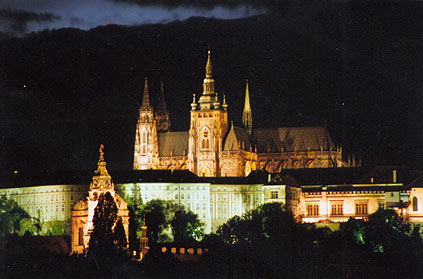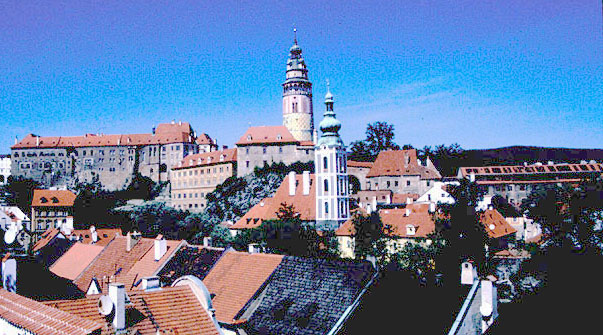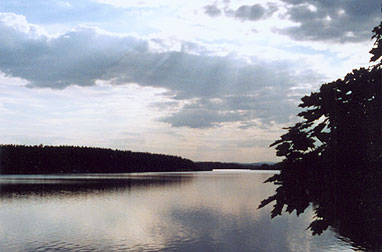|
The Czech Republic
 The Czech Republic is a small
country in the heart of Europe which has an appeal for visitors.Thanks to its
location at the crossroads of various cultures, the Czech Republic has
countless cultural and historical points of interest. Despite the complicated
visa rules, these destinations attracted a relatively high number of foreign
tourists even before the Velvet Revolution. The Czech Republic is a small
country in the heart of Europe which has an appeal for visitors.Thanks to its
location at the crossroads of various cultures, the Czech Republic has
countless cultural and historical points of interest. Despite the complicated
visa rules, these destinations attracted a relatively high number of foreign
tourists even before the Velvet Revolution.
The country has only recently returned to the economic and
political freedom of a democratic system.
The Czech Republic and the Slovak Republik were founded on 1.1.1993 after the
division of Czechoslovakia.
The country is situated in the middle of Europe and is the hub of several major
areas including Western and Eastern Europe, the Balkans and Scandinavia. The
Czech Republic also shares the longest border with the strongest economical
power in Europe, the Federal Republic of Germany. Its physical land area puts
it into the category of a smaller country. In size order, it falls into the
21st place, following Hungary, Portugal and Austria, ahead of Ireland,
Lithuania and Latvia. The number of inhabitants places the total population of
the Czech Republic 14th in Europe after Hungary, Portugal and Belorussia, ahead
of Greece and Belgium.
Aside from the Czechs: Moravians, Silesians, Slovaks, Germans, Polish, Roms and
other nationalities also inhabit the culturally diverse country.
Bohemia, the official name of the region, is derived from Celtic tribe Boii;
who were the first inhabitants of the place we are now call Bohemia. There is
also definitive evidence that the area also was once occupied by the Slavs in
the 6th century A.D. The long history of Bohemia and
Moravia can be traced through Samo's empire, the Great Moravian empire, the
reign of the Premysl's, the Luxemburg and Habsburg dynasties, the Catholic
expansion leading to the Thirty-Year War, the decline of the Austro-Hungarian
empire up to the birth of the Czechoslovakia Republic led by the first
president, Tomas Garigue Masaryk. After surviving the German occupation and
forty years of communist rule, the Czech Republic is now experiencing yet
another stage of transition, this time to a completely restructured
free-market. we are now call Bohemia. There is
also definitive evidence that the area also was once occupied by the Slavs in
the 6th century A.D. The long history of Bohemia and
Moravia can be traced through Samo's empire, the Great Moravian empire, the
reign of the Premysl's, the Luxemburg and Habsburg dynasties, the Catholic
expansion leading to the Thirty-Year War, the decline of the Austro-Hungarian
empire up to the birth of the Czechoslovakia Republic led by the first
president, Tomas Garigue Masaryk. After surviving the German occupation and
forty years of communist rule, the Czech Republic is now experiencing yet
another stage of transition, this time to a completely restructured
free-market.
Over the centuries a whole number of Czech men and women have become famous
throughout the world – the Holy Roman Emperor Charles IV, the reformer John
Huss (Jan Hus), the "Teacher of Nations" Comenius (Jan Amos Komensky), the
composers Bedrich Smetana, Antonin Dvorak and Leos Janacek, the writers
Jaroslav Hasek, Karel Capek and Franz Kafka, the Nobel Prize winners Jaroslav
Heyrovsky and Jaroslav Seifert, the opera stars Emmy Destinn and Jarmila
Novotna etc.
The Czech Republic is a country of great historical and cultural importance, a
country where historic monuments and entire towns have been included on the
World Heritage List. Of course, when discussing tourism in the Czech Republic, one
can not overlook the overwhelmingly popular tourist destination of Prague. The
city is generaly considered to be one of the most beautiful world capitals with
an exquitely preserved historical center.
Many other towns and historic monuments in the Czech Republic are
well-preserved and are noted in the UNESCO register as world cultural
landmarks: Kutna Hora, Telc, Cesky Krumlov, the Church of St.John of Nepomuk on
Zelena Hora, the Lednicko-Valticko area, monuments in Kromeriz, Holasovice
village, the castle and historical center at Litomysl and some rare monuments
and areas in Brno, Olomouc and Trebic. Some of the towns are also known as
glowing assets of the Czech Republic due to the existence of curative mineral
spring spas there. Spas like Karlovy Vary (Karlsbad) and Marianske Lazne
(Marienbad) acquired their international eminence many years ago. Jachymov,
another town in the countryside, is well known for its rare radioactive
springs. Terezin is also often explored by tourists, but unfortunately its
history is stained by war. Terezin was a fortress town from the end of the 18th
century which, during the war, was transformed into a Jewish ghetto by the
Nazis.
 The Czech nation has been
through good times and bad, times when it was in the forefront of world events
and times when its national rights were denied through foreign oppression. The Czech nation has been
through good times and bad, times when it was in the forefront of world events
and times when its national rights were denied through foreign oppression.
The Czech Republic also has good venues available for congress,
cultural, market, incentive and spa tourism.Prague remains the greatest tourist
magnet. It is beautiful all year round, but it is most beautiful in spring,
when it comes alive with blossom. With the opening of the Prague Spring
Festival, the concert halls and gardens of the city attract music-lovers from
all over the world. Winter, however, is a time for people to visit the
mountains.
The Giant Mountains are the highest and most beautiful range in
the country. Summer is a time for hiking in the countryside or swimming in the
countless lakes and reservoirs. At this time of year South Bohemia, with its
lakes and extensive forests, is the place to visit. Autumn is best during the
wine festival in South Moravia after the grapes have been harvested.
Czech Republic has much to offer to tourists from all
around the world. There is something for everyone here.
Why not come and see the Czech Republic for yourself!
Basic information
The country is a democratic republic, there are two legislative chambers - the
Chamber of Deputies and the Senate
Economic structure
agriculture, hunting and forestry, fishing 5%
mining and quarrrying 2,2%
manufacturing 26,6 %
electricity, gas and water supply 5 %
construction 6,8 %
wholesale and retail trade 13.5 %
transport, storage, communication 6,1 %
financial intermediation 7,6 %
others 27,2 %
Population and religion
Population: 10,3 million (in 1998)
Education: compulsory 9-year school attendance (from the age of 6), about 4
million people have complete secondary education and 0,5 million university
education
Official language: Czech
Ethnic composition: Czech - 94 % (Bohemians, Moravians, Silesians), Slovak -
3%, Rom - 1,3 %, Polish - 0,6%, German - 0,5 %, others - 0,6 %
Religions: Roman Catholic - 39,2 %, Protestant churches - 4,1 %, atheists and
non-believers - 39,7 %, others - 17 %
Largest cities: Prague (capital), Brno, Ostrava, Plzen, Olomouc, Liberec,
Hradec Kralove
Currency
1 crown (koruna - Kc) = 100 hellers (hal)
Geographical position
Total area: 78,865 sq. kilometres
latitude 49 - 51 degrees N and longitude 12-19 degrees E
Neighbouring states: Germany, Austria, Slovakia and Poland.
Length of state borders: 2,303 kilometres
Climate
temperate, a mixture of oceanic and continental, average winter temperature is
5 degrees C, average summer temperature is 20 degrees C
Annual precipitation: 500 - 700 mm
Average height above sea level: 450 metres (European average is 315 m), the
highest mountain is Mount Snezka 1,602.
The longest rivers: Labe 1 165 km (415 km in the country), Vltava 433 km.
Time zone
GMT plus 1 hour, from April to October summer time - GMT plus 2 hours
Copyright: Prague Information Service
|

